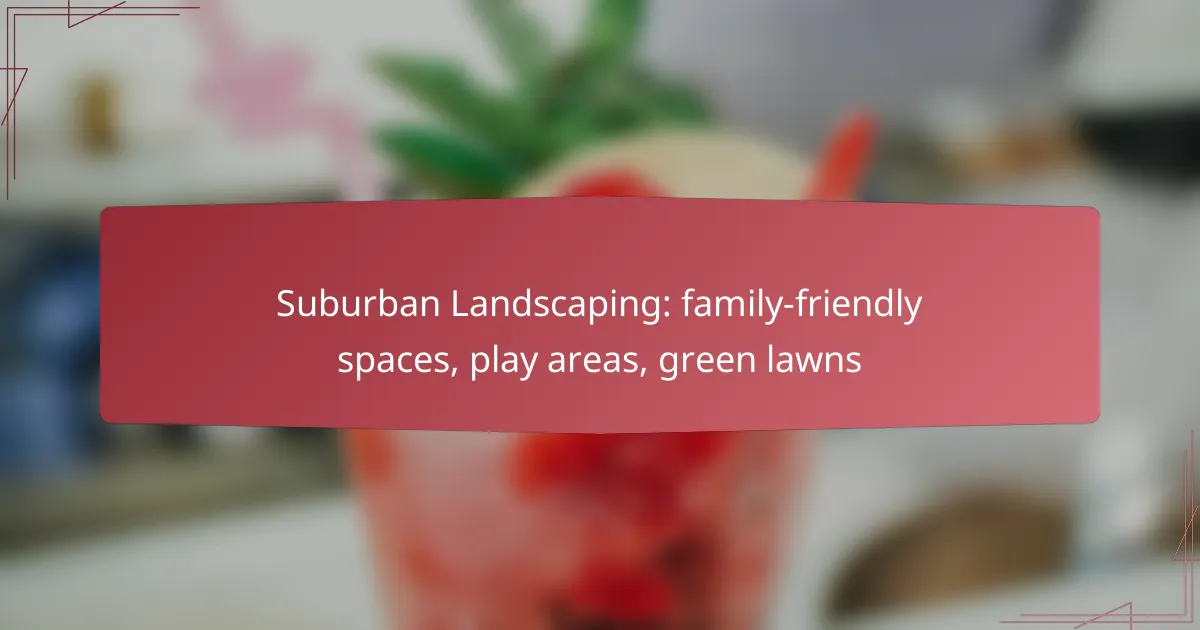Suburban landscaping can transform outdoor spaces into family-friendly environments that prioritize safety and engagement for children. By incorporating play areas with natural materials and soft ground cover, along with lush, drought-resistant lawns, families can enjoy a vibrant and accessible outdoor experience. Selecting non-toxic plants and durable furniture further enhances these spaces, making them welcoming for all ages.

How to create family-friendly landscaping in suburban areas?
Creating family-friendly landscaping in suburban areas involves designing spaces that are safe, engaging, and accessible for children and families. Focus on incorporating play zones, using non-toxic plants, and ensuring durability in outdoor furniture to foster a welcoming environment.
Incorporate safe play zones
Safe play zones are essential for family-friendly landscaping. Designate areas with soft surfaces, such as grass or rubber mulch, to cushion falls and prevent injuries. Consider adding features like climbing structures, swings, or sandbox areas that encourage active play.
Ensure that play zones are visible from the house to allow for easy supervision. Installing fencing around these areas can enhance safety, especially if your yard is near a road or water feature.
Use non-toxic plants
Selecting non-toxic plants is crucial for ensuring the safety of children and pets in your landscaping. Opt for native plants that are less likely to be harmful if ingested, such as marigolds, sunflowers, and certain herbs like basil and mint.
Research any plants you consider for your garden to ensure they are safe. The ASPCA provides a comprehensive list of non-toxic plants that can help guide your selections.
Design interactive gardens
Interactive gardens engage children and promote learning through play. Incorporate elements like sensory gardens with various textures, scents, and colors, or vegetable patches where kids can help with planting and harvesting.
Consider adding features such as water elements, like small fountains or ponds, which can provide both aesthetic appeal and a fun way for children to explore nature. Raised garden beds can also make gardening more accessible for young ones.
Install durable outdoor furniture
Durable outdoor furniture is vital for family-friendly landscaping, as it withstands the wear and tear of active use. Choose materials like weather-resistant wood, metal, or high-quality plastic that can endure various weather conditions.
Ensure that furniture is stable and safe for children. Consider rounded edges and non-toxic finishes. Arrange seating areas to encourage family gatherings and supervision of play zones, creating a cohesive outdoor space for relaxation and enjoyment.

What are the best plants for green lawns in suburban settings?
The best plants for green lawns in suburban areas typically include drought-resistant grasses and native plants that thrive in local conditions. Choosing the right varieties can enhance the lawn’s appearance while minimizing maintenance and water usage.
Fescue grass for drought resistance
Fescue grass is an excellent choice for suburban lawns, particularly in regions prone to dry spells. This type of grass is known for its drought resistance, allowing it to maintain a lush appearance with less water compared to other varieties.
When selecting fescue, consider a blend of tall fescue and fine fescue for optimal results. Tall fescue offers a robust root system, while fine fescue provides a softer texture. Aim to establish a lawn with a mix that can thrive in your specific climate.
Bermudagrass for sunny areas
Bermudagrass is ideal for sunny suburban lawns, as it thrives in bright, warm conditions. This grass type is known for its durability and quick growth, making it suitable for high-traffic areas, such as play zones for children.
To maintain a healthy Bermudagrass lawn, ensure it receives adequate sunlight and regular mowing. Fertilizing during the growing season can also promote lush growth, but be cautious not to over-fertilize, which can lead to thatch buildup.
Native wildflowers for biodiversity
Incorporating native wildflowers into suburban landscaping can enhance biodiversity and provide habitat for local wildlife. These plants are adapted to the local climate and soil conditions, making them easier to maintain than non-native species.
Consider planting a mix of wildflowers that bloom at different times throughout the growing season. This approach not only adds color to your landscape but also supports pollinators like bees and butterflies. Avoid using pesticides to protect these beneficial insects.

How to design effective play areas in suburban landscapes?
Designing effective play areas in suburban landscapes involves creating safe, engaging, and accessible spaces for children. Focus on using natural materials, ensuring safety through visibility, and incorporating soft ground cover to enhance the play experience.
Use natural materials for play structures
Natural materials like wood, stone, and bamboo are ideal for constructing play structures. They blend seamlessly into suburban landscapes and provide a warm, inviting atmosphere. Choose untreated wood to avoid harmful chemicals, and ensure that any materials used are durable and weather-resistant.
Consider features such as wooden climbing frames, log balance beams, or stone seating areas. These elements not only encourage imaginative play but also promote physical activity among children. Always check for local regulations regarding the use of materials to ensure compliance.
Incorporate soft ground cover
Soft ground cover is essential for minimizing injuries during play. Options like rubber mulch, grass, or engineered wood fiber provide cushioning and reduce the risk of falls. Aim for a minimum depth of 12 inches for loose-fill materials to ensure adequate safety.
In addition to safety, soft ground cover can enhance the aesthetics of your play area. Consider planting low-maintenance ground covers like clover or using natural grass to create a lush, green environment. Regular maintenance is necessary to keep the area safe and visually appealing.
Ensure visibility for safety
Visibility is crucial for safety in play areas, allowing parents to supervise children easily. Design the layout to minimize obstructions and ensure clear sightlines from various vantage points. Position play structures away from fences or dense shrubbery that could block views.
Incorporate open spaces around play equipment and use low plantings to maintain visibility. This approach not only enhances safety but also encourages social interaction among children and parents. Regularly assess the area for any new growth that may obstruct sightlines and trim as necessary.

What are the benefits of green lawns for families?
Green lawns provide numerous advantages for families, including improved aesthetics, recreational spaces, and environmental benefits. A well-maintained lawn creates a welcoming atmosphere for outdoor activities and enhances the overall quality of life for family members.
Improved air quality
Green lawns contribute to better air quality by absorbing carbon dioxide and releasing oxygen. This process helps reduce air pollution, making the environment healthier for children and adults alike. Additionally, lawns can trap dust, pollen, and other allergens, further improving the air families breathe.
To maximize air quality benefits, consider planting a variety of grasses and plants that thrive in your local climate. Native species often require less maintenance and provide better ecological support.
Safe play environment
A well-kept lawn offers a safe play area for children, cushioning falls and providing a clean surface for outdoor activities. Unlike hard surfaces like concrete, grass can help prevent injuries during playtime. Moreover, a green lawn encourages physical activity, promoting a healthier lifestyle for kids.
When designing play areas, ensure the lawn is free from harmful chemicals and sharp objects. Opt for organic lawn care practices to maintain a safe environment for children and pets.
Enhanced property value
Investing in a green lawn can significantly boost property value, making homes more attractive to potential buyers. A lush, well-maintained yard often leads to higher offers and quicker sales, as curb appeal plays a crucial role in real estate. Studies suggest that a well-landscaped property can increase value by a notable percentage.
To enhance property value, focus on regular lawn maintenance, including mowing, fertilization, and weed control. Consider integrating landscaping features like flower beds or trees to create a more inviting outdoor space.

What landscaping services are available in suburban areas?
Suburban areas typically offer a variety of landscaping services tailored to create family-friendly spaces, play areas, and lush green lawns. These services range from lawn care and maintenance to the installation of play structures and garden designs that enhance outdoor living.
Lawn care and maintenance
Lawn care and maintenance are essential for achieving a healthy, vibrant lawn in suburban settings. This includes regular mowing, fertilization, aeration, and weed control, which can be performed seasonally or as needed based on the lawn’s condition.
Homeowners should consider the type of grass suitable for their climate, as well as local soil conditions. For instance, cool-season grasses thrive in northern regions, while warm-season varieties are better for southern areas. A well-maintained lawn typically requires about 1 to 1.5 inches of water per week, either from rainfall or irrigation.
To ensure optimal lawn health, avoid common pitfalls such as over-fertilizing or mowing too short. Establish a regular maintenance schedule and consider hiring professional services if the task becomes overwhelming. Regular inspections can help identify issues like pests or diseases early, allowing for timely intervention.



